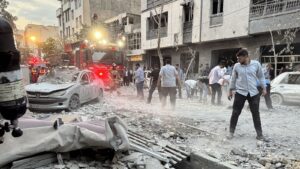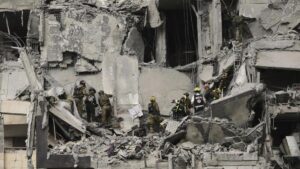Syrians Take to the Streets in Celebration Following the Collapse of Assad’s Government

In the streets of Damascus, the mood was one of jubilation as Syrians celebrated the dramatic downfall of President Bashar al-Assad’s regime, marking a historic turning point after over a decade of brutal civil war. On Monday, large crowds filled the streets, waving flags and taking selfies with an abandoned government tank in the city’s main square. Other residents of Damascus defaced or tore down the portraits of Assad that had been ubiquitous throughout the capital for years, a symbolic gesture of the regime’s end.
Celebrations also spread beyond the city. Hundreds of Syrian exiles, many of whom had fled the country during the conflict, streamed back into Syria from Lebanon through unguarded border crossings, eager to return to their homeland now that Assad’s government had collapsed. Meanwhile, just outside Damascus, a crowd gathered to destroy the statue of Hafez al-Assad, the father of Bashar and the former ruler of Syria, who had imposed a harsh dictatorship on the country for decades. In a powerful act of defiance, they brought the statue to the ground, then dragged it through the streets attached to the back of a truck as onlookers cheered.
As the celebratory atmosphere filled the streets, the air was also punctuated by the sound of gunfire, with rebel fighters firing AK-47s into the air in celebration. Drivers honked their horns, and Syrians of all ages could be heard chanting “Hurriyah! Hurriyah!” meaning “Freedom! Freedom!” People celebrated not only the end of Assad’s reign but the prospect of a new beginning after years of suffering.
The fall of Assad’s government came as a result of a surprise military offensive by Hayat Tahrir al-Sham (HTS), a militant group that had once been a branch of Al Qaeda. The HTS fighters swept into Damascus, and within a matter of days, they had taken control of the capital and effectively ended the civil war. Assad, along with his immediate family, fled to Russia, where they were granted asylum by President Vladimir Putin.
Once in control, HTS leader Abu Mohammad al-Jolani, who had been a key figure in the militant group, arrived in Damascus shortly after Assad’s departure. Wearing military fatigues, al-Jolani ordered his forces to refrain from harming civilians and to prevent looting, though reports suggest that many Syrians took advantage of the chaos to loot Assad’s abandoned palaces and luxury cars left behind by the former dictator.
One of the first actions of the HTS forces was to storm the notorious prisons that had been used by the Assad regime to hold thousands of prisoners under inhumane conditions. Many of these prisoners had been subjected to torture, including sexual abuse. The release of these detainees symbolized a break from the oppressive practices of the Assad government, bringing a sense of justice to many Syrians who had endured suffering for years.
Despite the celebratory atmosphere in Syria, concerns about the future persist. While many Syrians rejoiced at the fall of Assad’s regime, the rise of Abu Mohammad al-Jolani and his militant group has raised fears that the country may merely be exchanging one oppressive rule for another. HTS, which was once part of Al Qaeda, has been designated a terrorist organization by both the United Nations and the United States. As a result, there is a level of uncertainty surrounding whether the country’s new leadership will bring about the peace and stability Syrians so desperately need.
In response to the fall of Assad, U.S. President Joe Biden stated, “At long last, the Assad regime has fallen,” acknowledging the significance of this moment in Syria’s long-running conflict. He emphasized that the United States would engage with all Syrian groups, including those involved in the United Nations-led process, to facilitate a peaceful transition away from the Assad regime.
However, as the world watches the developments in Syria, the next steps remain uncertain. While many Syrians have expressed hope that this marks the beginning of a new chapter in their country’s history, there are lingering fears about the future under the leadership of al-Jolani and HTS. Syria’s path forward will depend on whether the country can move beyond its legacy of dictatorship and begin the difficult process of rebuilding a society based on freedom, justice, and stability. For now, the celebrations in the streets of Damascus are a testament to the resilience of the Syrian people, even as they await the long road ahead.







